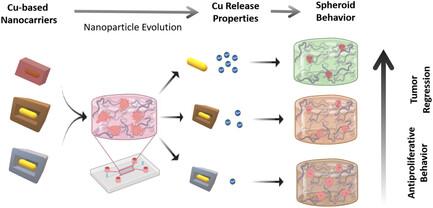The Pattern of Copper Release in Copper-Based Nanoparticles Regulates Tumor Proliferation and Invasiveness in 3D Culture Models
IF 11.1
Q1 MATERIALS SCIENCE, MULTIDISCIPLINARY
引用次数: 0
Abstract
Cancer is a leading cause of death worldwide. Glioblastoma (GBM) is a major challenge in oncology due to its highly invasive nature and limited treatment options. GBM's aggressive migration beyond tumor margins and rapid tumor growth hinders success in patient treatment. Localized therapeutic delivery, such as the use of transition metals like copper, is highlighted as a novel therapeutic agent for many potential biomedical applications. Herein, it is aimed to study the effects of Cu release on the proliferation and invasiveness of cancer cells. To this end, novel copper-based nanostructures with different release patterns are designed. Using a complex 3D cell culture model to mimic the tumor microenvironment, it is shown that different patterns of copper ion release have a strong impact on GBM progression and invasiveness. The findings highlight the importance of optimizing localized copper release patterns to tailor different tumor treatment strategies. They also show the potential and suitability of 3D microchips as instruments to study the behavior of tumor spheroids. In spite of their limitations, these 3D microdevices enable a controlled and close monitoring of the influence of environmental factors (such as the presence of Cu ions) on the proliferation and invasiveness of the cells, with a better approach to reality compared to 2D models and with a more controlled environment, compared to an in vivo model.

铜基纳米颗粒中的铜释放模式可调节三维培养模型中肿瘤的增殖和侵袭性
癌症是导致全球死亡的主要原因。胶质母细胞瘤(GBM)因其高度侵袭性和有限的治疗方案而成为肿瘤学的一大挑战。胶质母细胞瘤具有超出肿瘤边缘的侵袭性迁移和肿瘤的快速生长,阻碍了对患者的成功治疗。局部治疗给药,如使用铜等过渡金属,作为一种新型治疗剂,在许多潜在的生物医学应用中备受瞩目。本文旨在研究铜释放对癌细胞增殖和侵袭性的影响。为此,我们设计了具有不同释放模式的新型铜基纳米结构。利用复杂的三维细胞培养模型模拟肿瘤微环境,结果表明不同的铜离子释放模式对 GBM 的进展和侵袭性有很大影响。研究结果凸显了优化局部铜离子释放模式以定制不同肿瘤治疗策略的重要性。研究结果还显示了三维微芯片作为研究肿瘤球体行为的工具的潜力和适用性。尽管有其局限性,但这些三维微装置能对环境因素(如铜离子的存在)对细胞增殖和侵袭性的影响进行可控的密切监测,与二维模型相比更贴近现实,与体内模型相比环境更可控。
本文章由计算机程序翻译,如有差异,请以英文原文为准。
求助全文
约1分钟内获得全文
求助全文
来源期刊
CiteScore
14.00
自引率
2.40%
发文量
0
期刊介绍:
Small Science is a premium multidisciplinary open access journal dedicated to publishing impactful research from all areas of nanoscience and nanotechnology. It features interdisciplinary original research and focused review articles on relevant topics. The journal covers design, characterization, mechanism, technology, and application of micro-/nanoscale structures and systems in various fields including physics, chemistry, materials science, engineering, environmental science, life science, biology, and medicine. It welcomes innovative interdisciplinary research and its readership includes professionals from academia and industry in fields such as chemistry, physics, materials science, biology, engineering, and environmental and analytical science. Small Science is indexed and abstracted in CAS, DOAJ, Clarivate Analytics, ProQuest Central, Publicly Available Content Database, Science Database, SCOPUS, and Web of Science.

 求助内容:
求助内容: 应助结果提醒方式:
应助结果提醒方式:


